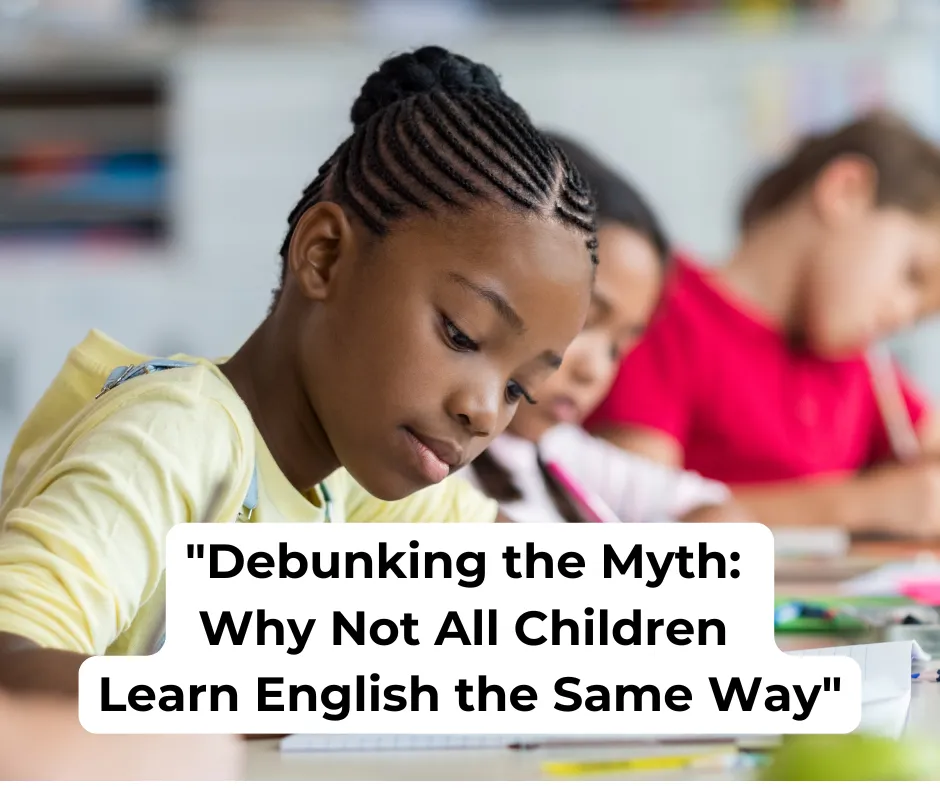"Debunking the Myth: Why Not All Children Learn English the Same Way"
Written by Miss Sealey April 2024

Debunking the Myth: Why Not All Children Learn English the Same Way
As parents, we often fall into the trap of believing that all children should learn in the same way, especially when it comes to core subjects like English. This belief is understandable—after all, schools typically follow a one-size-fits-all approach to teaching. However, the truth is that every child is unique, and so is their learning journey. In this blog, we’ll debunk the myth that all children learn English the same way and explore why understanding your child’s individual learning style is key to their success.
Myth: One Size Fits All
One of the most pervasive myths in education is that there is a single, best way for all children to learn. This myth can be particularly damaging when it comes to English, where reading, writing, and comprehension are often taught in a uniform manner. While some children may thrive in this environment, others may struggle, leading to frustration and a lack of confidence.
In reality, children have different strengths, interests, and learning styles. Some are visual learners who benefit from pictures and diagrams, while others are auditory learners who excel through listening and discussion. Then there are kinesthetic learners who need hands-on activities to grasp new concepts. Recognizing that your child may not fit into the traditional mold is the first step towards helping them succeed in English.
Understanding Learning Styles
Every child has a preferred way of learning, and understanding this can make a significant difference in their engagement and progress in English. Here are a few common learning styles:
Visual Learners: These children learn best through visual aids like charts, graphs, and videos. They may struggle with long passages of text but excel when information is presented in a visual format.
Auditory Learners: These children learn best through listening. They might find reading challenging but are excellent at following spoken instructions or engaging in discussions. Audiobooks, podcasts, and verbal explanations can be particularly effective for them.
Kinesthetic Learners: These children learn best through hands-on activities and movement. They may have difficulty sitting still for long periods or engaging with traditional reading and writing tasks but thrive when they can interact with their learning materials through physical activities.
Recognizing your child’s learning style allows you to tailor their English learning experience to their needs, making the process more enjoyable and effective.
Why Tailored Learning Matters
When children are forced to learn in a way that doesn’t suit their style, it can lead to disengagement and a lack of confidence. This is particularly true in English, where skills like reading and writing require a high level of focus and practice. If a child finds the material difficult or uninteresting, they may begin to see themselves as "bad" at English, which can have long-term consequences on their academic journey.
By tailoring the learning experience to your child’s unique needs, you can help them build confidence and develop a love for English. For example, if your child is a visual learner, incorporating more diagrams, mind maps, or even drawing exercises into their study routine can make a big difference. If they are an auditory learner, consider using discussion-based learning or allowing them to listen to stories and lectures. For kinesthetic learners, try to include more hands-on activities like role-playing or using physical objects to demonstrate concepts.
Debunking the Myth for Good
The idea that all children should learn English in the same way is outdated and counterproductive. Every child is unique, and their learning journey should reflect that. By understanding and respecting your child’s individual learning style, you can help them overcome challenges, build confidence, and achieve success in English.
In a world where education often emphasizes conformity, embracing your child’s uniqueness can be the key to unlocking their full potential. Remember, the goal isn’t just to get through the next English assignment—it’s to foster a lifelong love of learning that will serve them well beyond the classroom.

Miss Sealey
Miss Sealey supports KS2 students who are good at Math but struggle with English writing to significantly improve their skills, have fun while learning, build confidence and be exam ready. She lays a strong foundations for future academic success for your child by helping to overcome academic anxieties

